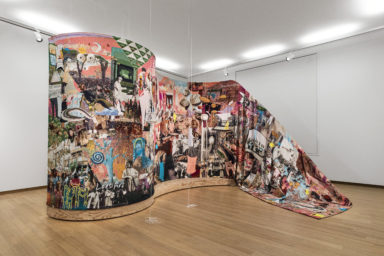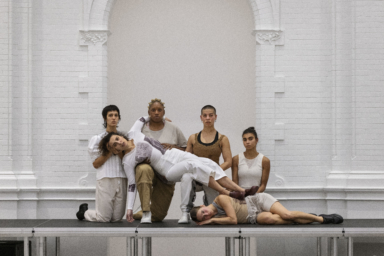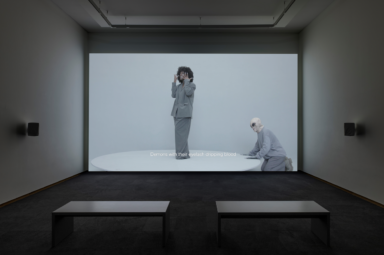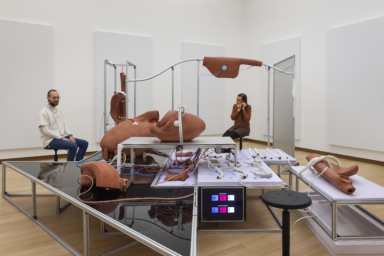Outgoing minister of Education, Culture and Science, Ingrid van Engelshoven will announce the winner of the 2021 Prix de Rome for the visual arts at Tuesday November 30th. The award ceremony will take place at Stedelijk Museum Amsterdam.
The 4 nominated artists are Mercedes Azpilicueta, Alexis Blake, Silvia Martes en Coralie Vogelaar. The award comes with a 40,000 Euros cash prize and the possibility to participate in a residency programme.
Live stream award ceremony
The award ceremony can be followed via a live stream from 4 to 4.30 pm. Language: Dutch.
Mercedes Azpilicueta
(Buenos Aires, Argentina, 1981, lives and works in Amsterdam)

Potatoes, Riots and Other Imaginaries explores unseen, often informal modes of social organization, and the forming of intimacy and solidarity in everyday life. This sculptural tapestry invites the public to view both sides of the woven material, in which subjects such as food economies, young female workers at textile factories, and women-led global rights movements coalesce. The artist draws these subjects together in the context of her research into the Potato Riots of 1917 in the Jordaan neighborhood of Amsterdam, organized by working class women in response to food shortages during the First World War.
Mercedes Azpilicueta has a particular interest in notions of the vulnerable or collective body, decolonial feminism and dissident voices. She brings together various characters from the past and the present, who manifest as voices, shapes, texts, traces and memories into multi-layered works.
Alexis Blake
(Pittsburg, USA, 1981, lives and works in Amsterdam)

Stepping through the narrowed corridor leading into the next exhibition room, in what seems to be an empty space, an experience of change occurs: the light and the smell—developed with smell researcher and artist Sissel Tolaas on the subject of decay—is different from in the rest of the museum. This exhibition room has been transformed into an atmosphere inspired by a proposition: Could this small museum gallery offer us the space we have been missing in society, a place where we can temporarily accommodate collective, invisible, and intangible senses following traumas, following mourning or loss?
This work takes place in conjunction with a performance situated around the monumental staircase of the historic museum building, through which Blake explores the outlawing by the Ancient Greeks of lamentation by women, involving cathartic wailing and highpitched exclamations that facilitated the collective processing of trauma.
For more information about the performance, please visit www.stedelijk.nl/en/performance/alexisblake.
Alexis Blake has a multidisciplinary practice that brings together visual art and performance through the use of choreography, sound, video, sculpture and printed matter. She investigates the way the body is represented in art history and beyond, which she then critically examines, disrupts and re-negotiates.
Silvia Martes
(Eindhoven, NL, 1985, lives and works in Amsterdam)

Photo: Daniel Nicolas
After passing through the specially designed corridor and taking a seat in the film room, the museum visitor sees a wall-filling projection of a film telling the story of three protagonists in 2121, a hundred years from now. It paints a picture of a possible future resulting from our behavior in the realms of technology and the climate. The narrative follows the three characters as they move through the remains of what was once Mother Earth. They are “the last standing.” One is a human with an external resemblance to the artist herself. Another is an audible but invisible being. The third is a non-binary robot that is suffering enormous guilt about the destructive role of technology. The three characters consult an oracle to gain some idea of what awaits humanity—rather than being a crystal ball that predicts the future, however, this oracle functions as a history book.
Silvia Martes produces experimental films, that appeal to the science fiction genre. Most of the times, the narratives of her short films find their origin in an autobiographical experience or are inspired by collective human behavior and yet show an intentional detachment and distraction from the real world.
Coralie Vogelaar
(Delft, NL, 1981, lives and works in Amsterdam)

The interactive installation Interpersonal Biofeedback Apparatus Encoding Cardiac Fluctuations examines our urge to exert control over our body, the uncontrollable nature of the conditions that influence how we feel, and the data systems that analyze our state of wellbeing. Visitors are invited to take a seat and place a sensor on their earlobe. Their heart rate variability (HRV), the period between heartbeats, will immediately become audible as the sound of ticking metal, friction on ceramics, and squeaking polystyrene. Changes in HRV directly impact on the sound composition by Sjoerd Leijten, and vice versa.
Coralie Vogelaar is an interdisciplinary artist who combines scientific disciplines such as behavioral studies and data analysis with artistic imagination. Fascinated by algorithms, she explores the tense relationship between human and machine. By collaborating with experts from various disciplines, her (video) installations and performances incorporate the application of machine logic to human bodies, and vice versa.
Exhibition
The final presentations Mercedes Azpilicueta, Alexis Blake Silvia Martes and Coralie Vogelaar can be viewed until 20 March 2022 at Stedelijk Museum Amsterdam.
Publication
The 2021 Prix de Rome is accompanied by a publication, published by Jap Sam Books, in cooperation with Mondriaan Fund. The artists are introduced by the authors Dagmar Dirkx and Esmee Postma. An introductory essay is written by Rein Wolfs (director Stedelijk Museum Amsterdam).
Photography: Daniel Nicolas. Design: Lesley Moore. Price: € 15
ISBN 978-94-92852- 45-8
www.japsambooks.nl
For the Prix de Rome 2021 the Mondriaan Fund works together with the Stedelijk Museum Amsterdam. Britte Sloothaak (curator) from the Stedelijk is responsible for the organisation of the exhibition.
The Prix de Rome is the oldest Dutch award for artists under the age of 40. The prize is funded and organized by the Mondriaan Fund.